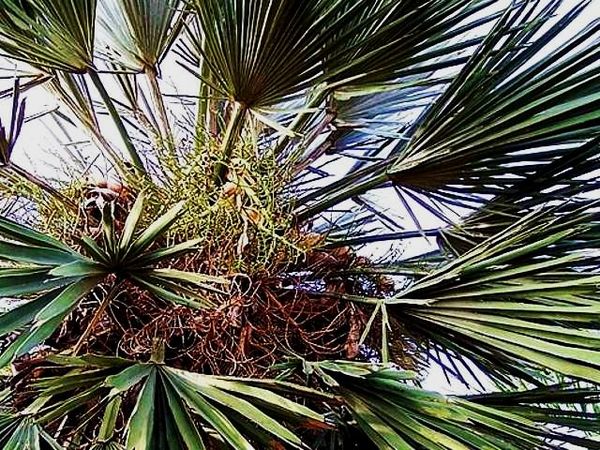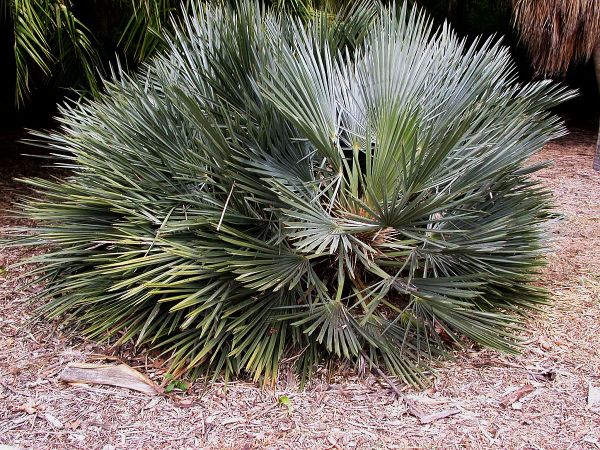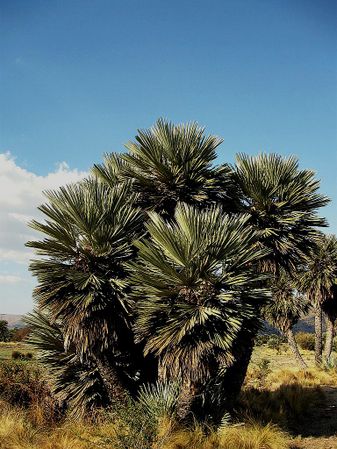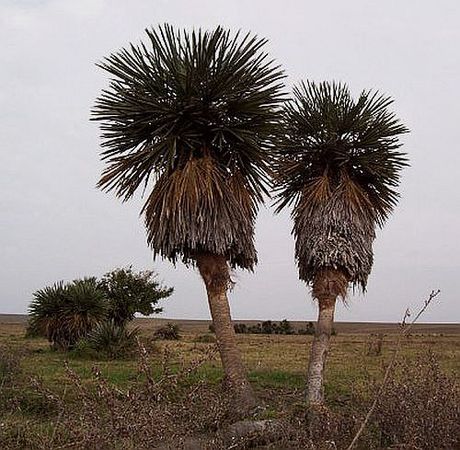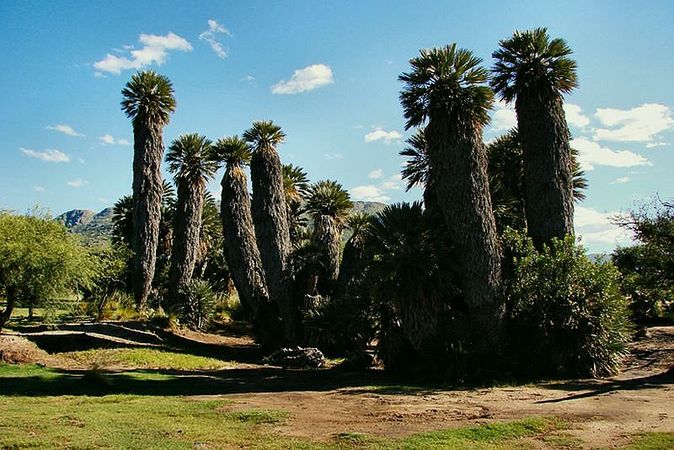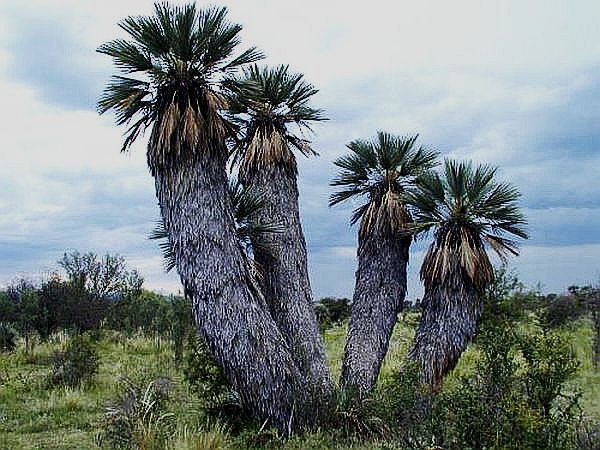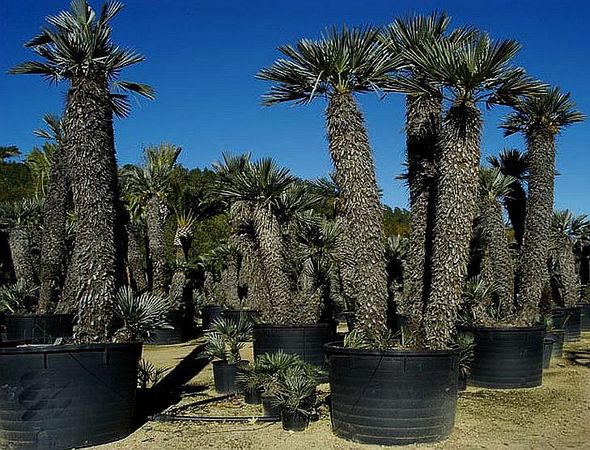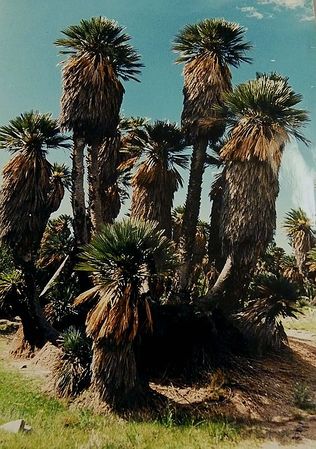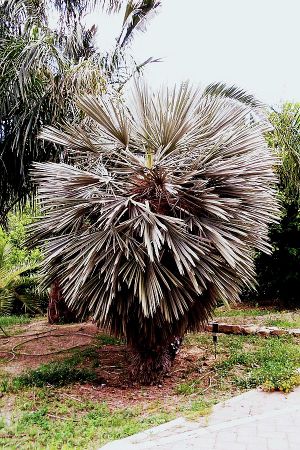Difference between revisions of "Trithrinax campestris"
Dypsisdean (Talk | contribs) |
|||
| Line 23: | Line 23: | ||
==Habitat and Distribution== | ==Habitat and Distribution== | ||
''Trithrinax campestris'' is found in Argentina Northeast, Argentina Northwest, and Uruguay. Present in savannas, but extends also to the summits of mountain ranges of Sierras de Córdoba and Sierras de San Luis. It is a very rustic palm that grows in arid, well drained, rocky soils. | ''Trithrinax campestris'' is found in Argentina Northeast, Argentina Northwest, and Uruguay. Present in savannas, but extends also to the summits of mountain ranges of Sierras de Córdoba and Sierras de San Luis. It is a very rustic palm that grows in arid, well drained, rocky soils. | ||
| − | [[Image:Trithrinax_campestris_at_Cordoba.JPG|thumb|left| | + | [[Image:Trithrinax_campestris_at_Cordoba.JPG|thumb|left|400px|Sierras de Guasapampa, west of Cordoba province, Argentina. Photo by Gaston Torres Vera, edric.]] |
==Description== | ==Description== | ||
| − | A medium sized palm (up to 6 m tall) and 20–25 cm wide stems, usually covered by remains of earlier foliage that act as a thick protective coat. Caranday leaves are about 1 m long, palmate, rounded, with a very rigid and spiny petiole. The leaflet segments are rigid, dark green to a more blue hue, with light green undersides, leaflet tips are armed. These are possibly the toughest leaves among arecaceae. As habitat altitude increases the foliage becomes more grayish, this is typical of mountain carandays. Flowers compose highly branched inflorescences located at the base of the lower living leaves. These contain up to 100 white hermaphrodite flowers 10 to 12 mm wide. This palm flowers in autumn. Fruits ripen towards the end of the next summer. They consist of subspherical yellow brownish drupes, 1 to 2 cm wide, with a thin fleshy mesocarp and a fibrous endocarp. Caranday is monoecious. Its distinctive features are its compact shape, short green to grayish foliage, and trunk fully hidden by dry dead branches (coat) remaining from several previous seasons | + | A medium sized palm (up to 6 m tall) and 20–25 cm wide stems, usually covered by remains of earlier foliage that act as a thick protective coat. Caranday leaves are about 1 m long, palmate, rounded, with a very rigid and spiny petiole. The leaflet segments are rigid, dark green to a more blue hue, with light green undersides, leaflet tips are armed. These are possibly the toughest leaves among arecaceae. As habitat altitude increases the foliage becomes more grayish, this is typical of mountain carandays. Flowers compose highly branched inflorescences located at the base of the lower living leaves. These contain up to 100 white hermaphrodite flowers 10 to 12 mm wide. This palm flowers in autumn. Fruits ripen towards the end of the next summer. They consist of subspherical yellow brownish drupes, 1 to 2 cm wide, with a thin fleshy mesocarp and a fibrous endocarp. Caranday is monoecious. Its distinctive features are its compact shape, short green to grayish foliage, and trunk fully hidden by dry dead branches (coat) remaining from several previous seasons. |
==Culture== | ==Culture== | ||
Trithrinax campestris prefers well drained, sandy or rocky soils (although it is ignorant to extended persistent flooding). It is very resistant to drought, and -9°C/-15°C temperatures when not in growing season; else leaves are promptly discarded. It is one of the most cold-hardy palms in the world, this is because it also grows in the mountains of Sierras de Córdoba and Sierras de San Luis, it is known that specimens growing at those elevations tolerate special cold conditions. It has thrived as north as the British Isles. Seeds germinate quickly but later growth is mostly slow. This palms are naturally found in groups, formations of several individuals or composing largue caranday forests where they present strong dominance. Its main environmental threat is deforestation or natural fire, caranday thick dry stem coats are highly flammable. Prefers a drier climate, with moderately cold winters. | Trithrinax campestris prefers well drained, sandy or rocky soils (although it is ignorant to extended persistent flooding). It is very resistant to drought, and -9°C/-15°C temperatures when not in growing season; else leaves are promptly discarded. It is one of the most cold-hardy palms in the world, this is because it also grows in the mountains of Sierras de Córdoba and Sierras de San Luis, it is known that specimens growing at those elevations tolerate special cold conditions. It has thrived as north as the British Isles. Seeds germinate quickly but later growth is mostly slow. This palms are naturally found in groups, formations of several individuals or composing largue caranday forests where they present strong dominance. Its main environmental threat is deforestation or natural fire, caranday thick dry stem coats are highly flammable. Prefers a drier climate, with moderately cold winters. | ||
| − | |||
Cold Hardiness Zone: 9a | Cold Hardiness Zone: 9a | ||
| + | <center> | ||
| + | [[{{PFC}}http://www.palmpedia.net/palmsforcal/index.php5/Trithrinax_campestris]] | ||
| + | </center> | ||
==Comments and Curiosities== | ==Comments and Curiosities== | ||
| + | Uses: Leaves are rich in strong fiber, very resistant to tension. They are used to manufacture crafts as hats, shoes and fans. Whole leaves are cut and used as rudimentary brushes. Fruits are not eaten, however, an alcoholic beverage is prepared locally through their fermentation. Caranday palms are also appreciated and grown worldwide as an easy to keep, cold weather and drought resistant, ornamental small palm. It is besides a good honey-producing plant. | ||
{{read more top}} | {{read more top}} | ||
| − | |||
| − | |||
In general, this species has one or more trunks 12 - 20cm in diameter and between 2 - 5m in high covered by the old leaves. The palmate leaves are green grizzly, hard and with petioles up to 60cm long. Fruits are brown to yellow when mature and the seeds germinate easily if fresh. Like the other Trithrinax species, the seed first grows a long root searching for water, after which the initial single seedling leaf grows very slowly. (José Grassia and Alberto Ferrari) | In general, this species has one or more trunks 12 - 20cm in diameter and between 2 - 5m in high covered by the old leaves. The palmate leaves are green grizzly, hard and with petioles up to 60cm long. Fruits are brown to yellow when mature and the seeds germinate easily if fresh. Like the other Trithrinax species, the seed first grows a long root searching for water, after which the initial single seedling leaf grows very slowly. (José Grassia and Alberto Ferrari) | ||
| Line 40: | Line 41: | ||
Surely this palm has the stiffest leaves of any! It is a "once seen, never forgotten" species that will grow in a wide range of climates, tolerating both desert heat and intense cold. Probably the most durable palm on earth! Its leaves are quite blue in color and stiff as sheet metal, and its trunk is covered with an intricate network of old leaf bases, recognizable by touch alone! (RPS.com) | Surely this palm has the stiffest leaves of any! It is a "once seen, never forgotten" species that will grow in a wide range of climates, tolerating both desert heat and intense cold. Probably the most durable palm on earth! Its leaves are quite blue in color and stiff as sheet metal, and its trunk is covered with an intricate network of old leaf bases, recognizable by touch alone! (RPS.com) | ||
{{read more bottom}} | {{read more bottom}} | ||
| − | |||
| − | |||
| − | |||
| − | |||
| − | |||
| − | |||
| − | |||
| − | |||
| − | |||
| − | |||
| − | |||
| − | |||
| − | |||
<center><gallery caption="IMAGE GALLERY" perrow="" widths="" heights=""> | <center><gallery caption="IMAGE GALLERY" perrow="" widths="" heights=""> | ||
image:Tc1346z.jpg|Argentina. Photo by M. Gibbons & T. Spanner/Palmtalk. | image:Tc1346z.jpg|Argentina. Photo by M. Gibbons & T. Spanner/Palmtalk. | ||
image:Tc1347z.jpg|Detail of fibre spines. Argentina. Photo by M. Gibbons & T. Spanner/Palmtalk. | image:Tc1347z.jpg|Detail of fibre spines. Argentina. Photo by M. Gibbons & T. Spanner/Palmtalk. | ||
image:Tc1348z.jpg|Huntington Botanic Garden, California. Photo by Dr. John Dransfield, Royal Botanic Gardens, Kew/Palmweb. | image:Tc1348z.jpg|Huntington Botanic Garden, California. Photo by Dr. John Dransfield, Royal Botanic Gardens, Kew/Palmweb. | ||
| − | image:Trithrinax_campestris_at_Cordoba.JPG|Sierras de Guasapampa, west of Cordoba province, Argentina. Photo by Gaston Torres Vera | + | image:Trithrinax_campestris_at_Cordoba.JPG|Sierras de Guasapampa, west of Cordoba province, Argentina. Photo by Gaston Torres Vera |
| − | Image:Trithrinax campestris P.jpg|Ventura, California. Photo by Geoff Stein | + | Image:Trithrinax campestris P.jpg|Ventura, California. Photo by Geoff Stein |
| − | image:Trithrinax_campestris00.jpg|Du jardin botanique de La Rochelle (france). Photo by Benjamin Grassineau | + | image:Trithrinax_campestris00.jpg|Du jardin botanique de La Rochelle (france). Photo by Benjamin Grassineau |
image:Caranday_corona_2.jpg | image:Caranday_corona_2.jpg | ||
| − | image:Caranday_formation_2.jpg|Pampa de Pocho, Argentina. Photo by Abestrobi | + | image:Caranday_formation_2.jpg|Pampa de Pocho, Argentina. Photo by Abestrobi |
| − | image:Trithrinax_campestris_chem.JPG|California. Photo by Geoff Stein | + | image:Trithrinax_campestris_chem.JPG|California. Photo by Geoff Stein |
| − | image:Trithrinax_campestris_clump_LA_arb.jpg|L.A. Arboretum, California. Photo by Geoff Stein | + | image:Trithrinax_campestris_clump_LA_arb.jpg|L.A. Arboretum, California. Photo by Geoff Stein |
| − | image:Trithrinax_campestris_flowering_Oct.jpg|California. Photo by Geoff Stein | + | image:Trithrinax_campestris_flowering_Oct.jpg|California. Photo by Geoff Stein |
| − | image:Trithrinax_campestris_LA_arb.jpg|California. Photo by Geoff Stein | + | image:Trithrinax_campestris_LA_arb.jpg|California. Photo by Geoff Stein |
| − | image:Trithrinax_campestris_P_update.jpg|California. Photo by Geoff Stein | + | image:Trithrinax_campestris_P_update.jpg|California. Photo by Geoff Stein |
| − | image:Trithrinax_campestris_skirt_again.JPG|California. Photo by Geoff Stein | + | image:Trithrinax_campestris_skirt_again.JPG|California. Photo by Geoff Stein |
| − | image:Trithrinax_campestris_spines.JPG|California. Photo by Geoff Stein | + | image:Trithrinax_campestris_spines.JPG|California. Photo by Geoff Stein |
| − | image:Trithrinax_sp..JPG|California. Photo by Geoff Stein | + | image:Trithrinax_sp..JPG|California. Photo by Geoff Stein |
| − | File:faa20f.jpg|Southern California. Photo by Geoff Stein | + | File:faa20f.jpg|Southern California. Photo by Geoff Stein |
| − | File:ba327a.jpg|Huntington Beach, California. Photo by Geoff Stein | + | File:ba327a.jpg|Huntington Beach, California. Photo by Geoff Stein |
| − | File:289746.jpg|Ventura, California. Photo by Geoff Stein | + | File:289746.jpg|Ventura, California. Photo by Geoff Stein |
| − | File:e4a942.jpg|Southern California. Photo by Geoff Stein | + | File:e4a942.jpg|Southern California. Photo by Geoff Stein |
| − | File:6dc957.jpg|Huntington Gardens, California. Photo by Geoff Stein | + | File:6dc957.jpg|Huntington Gardens, California. Photo by Geoff Stein |
| − | File:e4fbfe.jpg|Southern California. Photo by Geoff Stein | + | File:e4fbfe.jpg|Southern California. Photo by Geoff Stein |
| − | File:237236.jpg|Southern California. Photo by Geoff Stein | + | File:237236.jpg|Southern California. Photo by Geoff Stein |
| − | File:58602d.jpg|Southern California. Photo by Geoff Stein | + | File:58602d.jpg|Southern California. Photo by Geoff Stein |
| − | File:271f10.jpg|Palm Desert, California. Photo by Geoff Stein | + | File:271f10.jpg|Palm Desert, California. Photo by Geoff Stein |
| − | File:b16eac.jpg|San Diego Botanic Garden, California. Photo by growin | + | File:b16eac.jpg|San Diego Botanic Garden, California. Photo by growin |
| − | File:be64fb.jpg|San Diego Botanic Garden, California. Photo by growin | + | File:be64fb.jpg|San Diego Botanic Garden, California. Photo by growin |
| − | File:fdae25.jpg|Huntington Botanical Gardens, California. Photo by growin | + | File:fdae25.jpg|Huntington Botanical Gardens, California. Photo by growin |
| − | File:5665ba.jpg|Huntington Botanical Gardens, California. Photo by growin | + | File:5665ba.jpg|Huntington Botanical Gardens, California. Photo by growin |
| − | File:83b611.jpg|Huntington Botanical Gardens, California. Photo by growin | + | File:83b611.jpg|Huntington Botanical Gardens, California. Photo by growin |
| − | image:Trithinaxcampestris.jpg|Tonga apartments. Ventura CA. Photo by Troy Donovan | + | image:Trithinaxcampestris.jpg|Tonga apartments. Ventura CA. Photo by Troy Donovan |
| − | File:post-37-1202494400.jpg|Algarve, Portugal. Photo by Charles Wychgel | + | File:post-37-1202494400.jpg|Algarve, Portugal. Photo by Charles Wychgel |
| − | File:taIMGP3470-1.jpg|Tampa, Fl. Photo by Brad-Tampa | + | File:taIMGP3470-1.jpg|Tampa, Fl. Photo by Brad-Tampa |
| − | File:252266034_3orbE-L.jpg|North Carolina. Photo by Cindy | + | File:252266034_3orbE-L.jpg|North Carolina. Photo by Cindy |
| − | File:post--1203015716.jpg|L.A. Arboretum, CA. Photo by Matty Bradford | + | File:post--1203015716.jpg|L.A. Arboretum, CA. Photo by Matty Bradford |
| − | File:Trithrinax_campestrisB.jpg|Cordoba, Argentina. Photo by Gaston Torres Verra | + | File:Trithrinax_campestrisB.jpg|Cordoba, Argentina. Photo by Gaston Torres Verra |
| − | File:Trithrinax_campestrisB02.jpg|Cordoba, Argentina. Photo by Gaston Torres Verra | + | File:Trithrinax_campestrisB02.jpg|Cordoba, Argentina. Photo by Gaston Torres Verra |
| − | File:Trithrinax_campestrisB03.jpg|Cordoba, Argentina. Photo by Gaston Torres Verra | + | File:Trithrinax_campestrisB03.jpg|Cordoba, Argentina. Photo by Gaston Torres Verra |
| − | File:FloradeSan Luis.JPG|Argentina. Photo by Carlos A. Norverto | + | File:FloradeSan Luis.JPG|Argentina. Photo by Carlos A. Norverto |
| − | File:Trithrinax_campestris-_Soriano,_Palmar,_Bosque_parque_al_margen_del_Arroyo_Vera_3.jpg|Soriano, Uruguay. Photo by Andrés González | + | File:Trithrinax_campestris-_Soriano,_Palmar,_Bosque_parque_al_margen_del_Arroyo_Vera_3.jpg|Soriano, Uruguay. Photo by Andrés González |
File:8497509759_67d361ab2d_h.jpg|Jardín Botánico de La Concepción, Spain. Photo by José A. Conde | File:8497509759_67d361ab2d_h.jpg|Jardín Botánico de La Concepción, Spain. Photo by José A. Conde | ||
File:tcDSCF2357.JPG|Intihuasi, Córdoba, Argentina. | File:tcDSCF2357.JPG|Intihuasi, Córdoba, Argentina. | ||
| Line 108: | Line 96: | ||
File:TriCam_seeds.jpg|Rare Palm Seeds.com | File:TriCam_seeds.jpg|Rare Palm Seeds.com | ||
</gallery></center> | </gallery></center> | ||
| + | ==External Links== | ||
| + | *[http://eunops.org/content/glossary-palm-terms Glossary of Palm Terms] | ||
| + | *[http://www.calflora.net/botanicalnames/pronunciation.html MODERN BOTANICAL LATIN] | ||
| + | *[http://www.jlhudsonseeds.net/Pronunciation.htm "Just To Be Clear"] | ||
| + | *http://www.youtube.com/watch?v=Q8ysZ2N-2Ww | ||
| + | *http://www.photomazza.com/?Trithrinax-campestris | ||
| + | ==References== | ||
| + | Phonetic spelling of Latin names by edric. | ||
| + | |||
| + | Special thanks to Geoff Stein, (Palmbob) for his hundreds of photos. | ||
| + | |||
| + | Special thanks to [http://palmweb.org/?q=node/2 Palmweb.org], Dr. John Dransfield, Dr. Bill Baker & team, for their volumes of information and photos. | ||
| + | |||
| + | Glossary of Palm Terms; Based on the glossary in Dransfield, J., N.W. Uhl, C.B. Asmussen-Lange, W.J. Baker, M.M. Harley & C.E. Lewis. 2008. Genera Palmarum - Evolution and Classification of the Palms. Royal Botanic Gardens, Kew. All images copyright of the artists and photographers (see images for credits). | ||
{{SpeciesListBackLink}} | {{SpeciesListBackLink}} | ||
[[Category:TRITHRINAX|campestris]] | [[Category:TRITHRINAX|campestris]] | ||
Revision as of 22:20, 11 August 2015
Thatch Palm, Blue Needle Palm, Caranday Palm
| Trithrinax (tree-TREE-naks) campestris (kahm-PEHS-trihs) | |||||||
|---|---|---|---|---|---|---|---|
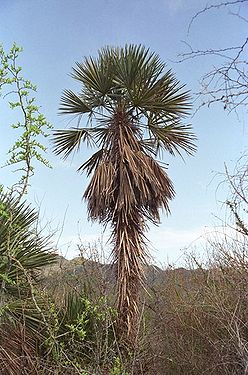 Argentina. Photo by M. Gibbons & T. Spanner/Palmtalk. | |||||||
| Scientific Classification | |||||||
| |||||||
| Synonyms | |||||||
|
| |||||||
| Native Continent | |||||||
|
| |||||||
| Morphology | |||||||
| |||||||
| Culture | |||||||
|
| |||||||
| Survivability index | |||||||
|
| |||||||
| Common names | |||||||
|
| |||||||
Contents
Habitat and Distribution
Trithrinax campestris is found in Argentina Northeast, Argentina Northwest, and Uruguay. Present in savannas, but extends also to the summits of mountain ranges of Sierras de Córdoba and Sierras de San Luis. It is a very rustic palm that grows in arid, well drained, rocky soils.
Description
A medium sized palm (up to 6 m tall) and 20–25 cm wide stems, usually covered by remains of earlier foliage that act as a thick protective coat. Caranday leaves are about 1 m long, palmate, rounded, with a very rigid and spiny petiole. The leaflet segments are rigid, dark green to a more blue hue, with light green undersides, leaflet tips are armed. These are possibly the toughest leaves among arecaceae. As habitat altitude increases the foliage becomes more grayish, this is typical of mountain carandays. Flowers compose highly branched inflorescences located at the base of the lower living leaves. These contain up to 100 white hermaphrodite flowers 10 to 12 mm wide. This palm flowers in autumn. Fruits ripen towards the end of the next summer. They consist of subspherical yellow brownish drupes, 1 to 2 cm wide, with a thin fleshy mesocarp and a fibrous endocarp. Caranday is monoecious. Its distinctive features are its compact shape, short green to grayish foliage, and trunk fully hidden by dry dead branches (coat) remaining from several previous seasons.
Culture
Trithrinax campestris prefers well drained, sandy or rocky soils (although it is ignorant to extended persistent flooding). It is very resistant to drought, and -9°C/-15°C temperatures when not in growing season; else leaves are promptly discarded. It is one of the most cold-hardy palms in the world, this is because it also grows in the mountains of Sierras de Córdoba and Sierras de San Luis, it is known that specimens growing at those elevations tolerate special cold conditions. It has thrived as north as the British Isles. Seeds germinate quickly but later growth is mostly slow. This palms are naturally found in groups, formations of several individuals or composing largue caranday forests where they present strong dominance. Its main environmental threat is deforestation or natural fire, caranday thick dry stem coats are highly flammable. Prefers a drier climate, with moderately cold winters. Cold Hardiness Zone: 9a
Comments and Curiosities
Uses: Leaves are rich in strong fiber, very resistant to tension. They are used to manufacture crafts as hats, shoes and fans. Whole leaves are cut and used as rudimentary brushes. Fruits are not eaten, however, an alcoholic beverage is prepared locally through their fermentation. Caranday palms are also appreciated and grown worldwide as an easy to keep, cold weather and drought resistant, ornamental small palm. It is besides a good honey-producing plant.
| read more |
|---|
|
In general, this species has one or more trunks 12 - 20cm in diameter and between 2 - 5m in high covered by the old leaves. The palmate leaves are green grizzly, hard and with petioles up to 60cm long. Fruits are brown to yellow when mature and the seeds germinate easily if fresh. Like the other Trithrinax species, the seed first grows a long root searching for water, after which the initial single seedling leaf grows very slowly. (José Grassia and Alberto Ferrari) "Slow grower and viciously sharp, but an attractive plant. Takes many many years (20-30) to form any height. Clustering. Trunk has spines as well as leaf tips. Nice blue-silver-grey leaf color. Drought and extremely wind tolerant. From Argentina and Uraguay." (Geoff Stein), edric. Surely this palm has the stiffest leaves of any! It is a "once seen, never forgotten" species that will grow in a wide range of climates, tolerating both desert heat and intense cold. Probably the most durable palm on earth! Its leaves are quite blue in color and stiff as sheet metal, and its trunk is covered with an intricate network of old leaf bases, recognizable by touch alone! (RPS.com) |
- IMAGE GALLERY
External Links
- Glossary of Palm Terms
- MODERN BOTANICAL LATIN
- "Just To Be Clear"
- http://www.youtube.com/watch?v=Q8ysZ2N-2Ww
- http://www.photomazza.com/?Trithrinax-campestris
References
Phonetic spelling of Latin names by edric.
Special thanks to Geoff Stein, (Palmbob) for his hundreds of photos.
Special thanks to Palmweb.org, Dr. John Dransfield, Dr. Bill Baker & team, for their volumes of information and photos.
Glossary of Palm Terms; Based on the glossary in Dransfield, J., N.W. Uhl, C.B. Asmussen-Lange, W.J. Baker, M.M. Harley & C.E. Lewis. 2008. Genera Palmarum - Evolution and Classification of the Palms. Royal Botanic Gardens, Kew. All images copyright of the artists and photographers (see images for credits).
Many Special Thanks to Ed Vaile for his long hours of tireless editing and numerous contributions.









